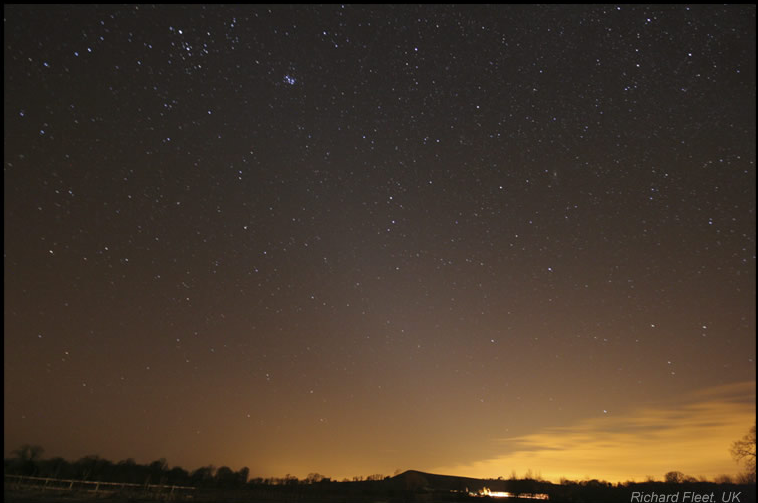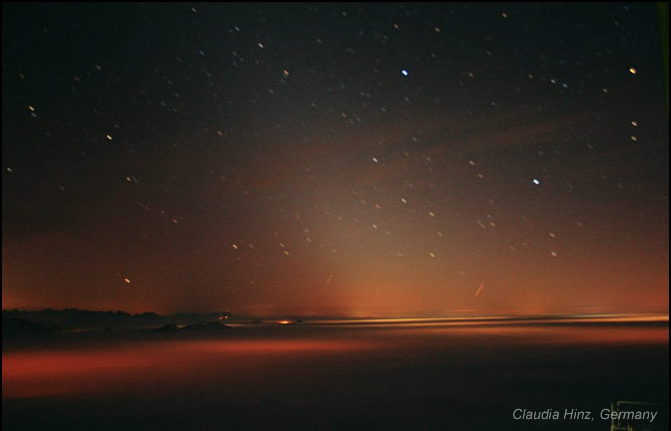March 2nd is your next chance!
March 2nd is your next chance to witness the breathtaking Zodiacal Light phenomenon!
Have you ever heard of the Zodiacal Light? It's a mesmerizing cone of soft light that extends upward from the horizon after sunset or before dawn. Often referred to as the "false dawn," this ethereal glow is caused by sunlight scattering off a disk of countless dust particles that extend outward in the plane of the Solar System, reaching as far as Jupiter and possibly beyond.
The Zodiacal Light is typically best observed in or near the tropics, where the skies are darker, and the ecliptic (the path of the Sun) is inclined at a significant angle to the horizon. However, you might be surprised to learn that even in more northerly and light-polluted regions like Europe, there are still opportunities to witness this celestial wonder.
Let's take a closer look at the Zodiacal Light and discover how you can increase your chances of experiencing its mystical beauty:
1. The Grandeur of the Zodiacal Light
The Zodiacal Light is an awe-inspiring sight that remains largely unseen by most people. While it is the largest feature in the solar system visible to the naked eye, it is often taken for granted in less developed parts of the world. Unfortunately, light pollution and our altering of natural skies have made this once-common phenomenon a rarity for many.
2. The Influence of Time and Latitude
The visibility of the Zodiacal Light depends greatly on the time of year and your latitude. Under optimal conditions, this phenomenon can be surprisingly bright, earning its moniker as the "False Dawn." In fact, you may notice signs of dawn hours before the sky begins to lighten. So, if you're in an area with clear skies and minimal light pollution, be sure to keep an eye out for this magical spectacle.
3. Captivating Images from Europe
Contrary to popular belief, the Zodiacal Light is not solely reserved for tropical regions. Stunning images captured by talented photographers in Europe prove that this phenomenon can be observed even in areas with higher levels of light pollution. Take, for example, the photographs by Richard Fleet and Claudia Hinz, showcasing the Zodiacal Light from Wiltshire, England, and the Bavarian Alps, Germany, respectively. These images serve as a testament to the perseverance of this ethereal glow against the backdrop of urbanization.
4. Tips for Observing the Zodiacal Light
If you're eager to witness the Zodiacal Light for yourself, here are a few tips to maximize your chances:
- Find a location away from city lights: Light pollution hampers visibility, so seek out areas with minimal artificial illumination.
- Choose the right time: The best opportunities to see the Zodiacal Light occur during the months when the ecliptic is most inclined to the horizon. In the northern hemisphere, this usually falls between late winter and early spring.
- Look for dark skies: Clear nights with little atmospheric interference provide optimal viewing conditions.
- Be patient and attentive: The Zodiacal Light may appear as a faint glow initially, so allow your eyes to adjust and scan the horizon patiently.
5. A Reminder of Nature's Beauty
The Zodiacal Light serves as a poignant reminder of the splendor and majesty of our natural world. As we gaze upon this celestial phenomenon, we are reminded of the wonders that exist beyond our daily routines and bustling cities. It encourages us to pause and appreciate the vastness of the universe and our place within it.
6. Conclusion
Mark your calendars for March 2nd, as it presents an opportunity to witness the captivating Zodiacal Light. Although traditionally associated with tropical regions, this extraordinary phenomenon can also be observed in more northerly and light-polluted areas like Europe. Remember to find a location away from city lights, choose the right time, and be patient as you gaze upon the soft cone of light stretching upward from the horizon. Let the Zodiacal Light inspire you to reconnect with the beauty of the natural world and the wonders that await beyond our everyday lives.

March 2nd is your next chance!
Upper image - Zodiacal light from Europe. Taken in Wiltshire, England on 14th February by Richard Fleet webmaster of Glows Bows & Haloes. 60s unguided exposure at f/4 ISO 1600, Canon 20D, Sigma 10-20mm lens at 10mm. Unprocessed JPG.
Lower image - On the same night by Claudia Hinz (Atmospheric optics site) from high on Mount Wendelstein in the Bavarian Alps, Germany. Unguided exposure.
Images © the photographers, shown with permission.

The zodiacal light is a soft cone of light stretching upwards from the horizon after sunset or before dawn when it is sometimes called the 'false dawn'. It is sunlight scattered by a disk of innumerable dust particles extending outwards in the plane of the Solar System to Jupiter and perhaps beyond.
The light is faint and is best seen in or near the tropics when skies are dark and the ecliptic - where it is concentrated - is strongly inclined to the horizon.
Is there hope of seeing it in more northerly and light polluted Europe? These images show that there is.
Richard Fleet gives these tips. �The Zodiacal Light is the largest feature in the solar system visible to the naked eye and yet most people have never seen it. From less developed parts of the world it is all part of the normal pattern of changing light between night and day and is easily taken for granted. It says a great deal about what we've done to our skies that something so commonplace should be regarded as a challenge for most people.
Time of year and latitude makes a huge difference to how visible it is. Under really favourable conditions it can be surprisingly bright, �False Dawn� isn't a bad name for it and you can tell the dawn is coming hours before the sky gets light.
Note: this article has been automatically converted from the old site and may not appear as intended. You can find the original article here.
Reference Atmospheric Optics
If you use any of the definitions, information, or data presented on Atmospheric Optics, please copy the link or reference below to properly credit us as the reference source. Thank you!
-
<a href="https://atoptics.co.uk/blog/march-2nd-is-your-next-chance/">March 2nd is your next chance!</a>
-
"March 2nd is your next chance!". Atmospheric Optics. Accessed on November 26, 2024. https://atoptics.co.uk/blog/march-2nd-is-your-next-chance/.
-
"March 2nd is your next chance!". Atmospheric Optics, https://atoptics.co.uk/blog/march-2nd-is-your-next-chance/. Accessed 26 November, 2024
-
March 2nd is your next chance!. Atmospheric Optics. Retrieved from https://atoptics.co.uk/blog/march-2nd-is-your-next-chance/.